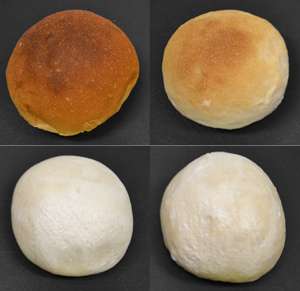The four types of bread made and tested by the A*STAR team. Top left, western baked bread; top right, modified baked bread (made with steamed bread ingredients); bottom left, oriental steamed bread; bottom right, modified steamed bread (made with baked bread ingredients). Credit: Adapted from Ref 1., Copyright (2015), with permission from Elsevier
Asian-style steamed bread has a lower glycemic index (GI) than western-style baked bread, A*STAR researchers have found1. This preparation method could be more widely adopted as a useful weapon in the battle against diseases such as obesity, heart disease and diabetes, they suggest.
Carbohydrates are a vital source of energy in the human diet, typically contributing up to 70 per cent of total energy intake. But, not all carbohydrates are equally wholesome. The glycemic index of food is used to measure how rapidly carbohydrates are converted to blood glucose—their 'glycemic response'. High-GI foods cause a rapid spike in blood glucose, while low-GI foods, considered 'healthier,' increase blood glucose gradually and sustain it for longer.
A team led by Jeyakumar Henry, of the A*STAR Institute for Clinical Sciences, examined the GI of bread, a carbohydrate-rich staple usually made from wheat flour. The GI of bread can vary significantly based on several factors, including the way in which it is cooked.
Henry and team compared bread baked in an oven, the traditional method in western countries, with the Asian-style bread, which is usually steamed. To assess the impact of both the ingredients and manufacturing methods, they also compared bread made with western ingredients but prepared using Asian methods (including steaming), and bread made with Asian ingredients processed with western methods (including baking).
The researchers tested the four types of bread in the laboratory, and by measuring the glycemic response of volunteer consumers—if they could stop themselves from eating it first! "It was hard to keep my hands off the freshly-baked bread," said Henry.
Both lab analysis and consumer blood tests revealed that the highest GI was found in bread made with Asian ingredients under western methods, and the lowest GI was found in bread made with western ingredients under Asian methods. Overall, processing, including cooking method, had a greater impact on GI than ingredients. Thus, the A*STAR team concluded, steaming is a healthier way of making bread than baking. Henry believes the implications may be far-reaching: "Given the worldwide interest in international cuisine, it may not be long before western consumers take to steamed bread, particularly when they know it has additional health benefits."
This research points to a whole new approach to reducing the GI of foods via processing and cooking methods, in addition to the established modification of the raw ingredients. Both the Health Promotion Board and commercial bread manufacturers in Singapore have already expressed an interest in the findings.
More information: Evelyn Lau et al. Can bread processing conditions alter glycaemic response?, Food Chemistry (2015). DOI: 10.1016/j.foodchem.2014.10.040
Journal information: Food Chemistry





















